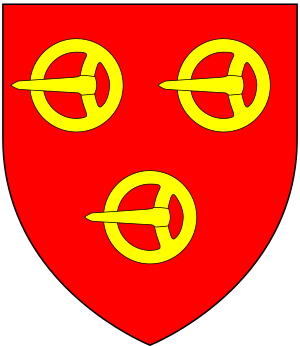Bonkyll Castle facts for kids
Quick facts for kids Bonkyll Castle |
|
|---|---|
| Berwickshire Scotland | |

The remains of Bonkyll Castle
|
|
| Coordinates | 55°49′42″N 2°18′41″W / 55.8284°N 2.31131°W |
| Type | Castle of Enceinte |
| Height | 1-3m present day |
| Site information | |
| Owner | Private |
| Open to the public |
No |
| Condition | ruined |
| Site history | |
| Built | 11th century |
| Built by | Bonkyl, Stewart, Douglas |
| In use | 11th–16th centuries |
| Materials | Stone |
Bonkyll Castle was a strong medieval fortress in Berwickshire, Scotland. Today, this area is part of the Scottish Borders. It was located about 4 miles north of Duns.
Not much of the castle remains today. The site is protected as a scheduled monument, which means it's an important historical place. Bonkyll Castle was once home to a branch of the powerful Stewart family. This family line eventually led to King James I & VI of Scotland and England.
Contents
What Bonkyll Castle Looked Like
Bonkyll Castle was a type of fortress called a castle of enceinte. This means it had strong walls forming an enclosure.
Today, you can mostly see the motte, which is a large mound of earth. This mound was where the castle's main tower or keep stood. There is also a small part of the original curtain wall still standing.
Who Owned Bonkyll Castle?
Over the centuries, different important families owned Bonkyll Castle.
The de Bonkyll Family
The castle was first owned by the de Bonkyll family. They even took their name from the castle! Their family coat of arms showed three buckles. This is called "canting" because "buckle" sounds a bit like "Bonkyll."
The last male owner from this family was Sir Alexander de Bonkyll. His daughter, Margaret de Bonkyll, inherited the castle. She married Sir John Stewart.
The Stewart Family of Bonkyll
- Sir John Stewart (died 1298) became known as "John Stewart of Bonkyll." He was the second son of Alexander Stewart, a very important Scottish leader. When he married Margaret de Bonkyll, he added the three buckles from her family's coat of arms to his own. This showed his connection to the Bonkyll family. The castle was damaged during the First War of Independence.
- Sir Alexander Stewart of Bonkyll (died 1319) was John's son.
- John Stewart, 1st Earl of Angus (died 1331) was Alexander's son. In 1328, he married Margaret de Abernethy, who was also an important heiress. In 1329, King Robert I of Scotland made him the Earl of Angus. This meant he controlled large areas of land in Berwickshire, Angus, and Kinross-shire.
- Thomas Stewart, 2nd Earl of Angus (died 1361) was John's son. He had no sons, so his daughter, Margaret Stewart, inherited everything.
- Margaret Stewart (died 1417) inherited the Earldom of Angus and Bonkyll Castle. She had a son, George Douglas, 1st Earl of Angus, with William Douglas, 1st Earl of Douglas.
The Douglas Family, Earls of Angus
After Countess Margaret died in 1417, Bonkyll Castle went to her son, George Douglas, 1st Earl of Angus. His family, the Douglas Earls of Angus, owned the castle until the late 1700s.
George Douglas, Master of Angus, who was Lord of Bonkyll, signed many important papers while living at the castle. Later, his wife, Elizabeth Drummond, owned it for a time.
The castle was also owned by Margaret Tudor, who was the Countess of Angus and the sister of King Henry VIII of England. In 1523, there was a plan for Margaret Tudor to pretend to help the people of the Scottish borders. The idea was that she would come to Bonkyll with her valuable items, and then be safely taken to England.
In 1593, the poet Patrick Hume of Polwarth was in charge of Bonkyll for King James VI. He used the money from the castle's lands to pay the king's huntsman.
The Earls of Home
In the late 1700s, Bonkyll Castle's ownership passed to the Earls of Home family.
A Local Rhyme
There's a famous old rhyme from Berwickshire that talks about how strong Bonkyll Castle and two other nearby castles, Billie Castle and Blanerne Castle, were. It says they were built when King David I was a child:
Bunkle, Billie and Blanerne
Three castles strong as airn
Built when Davie was a bairn
They'll all gang doon,
Wi' Scotland's Croon
And ilka ane shall be a cairn
This means: "Bunkle, Billie and Blanerne, Three castles strong as iron, Built when David was a child, They'll all go down, With Scotland's Crown, And every one shall be a pile of stones."




